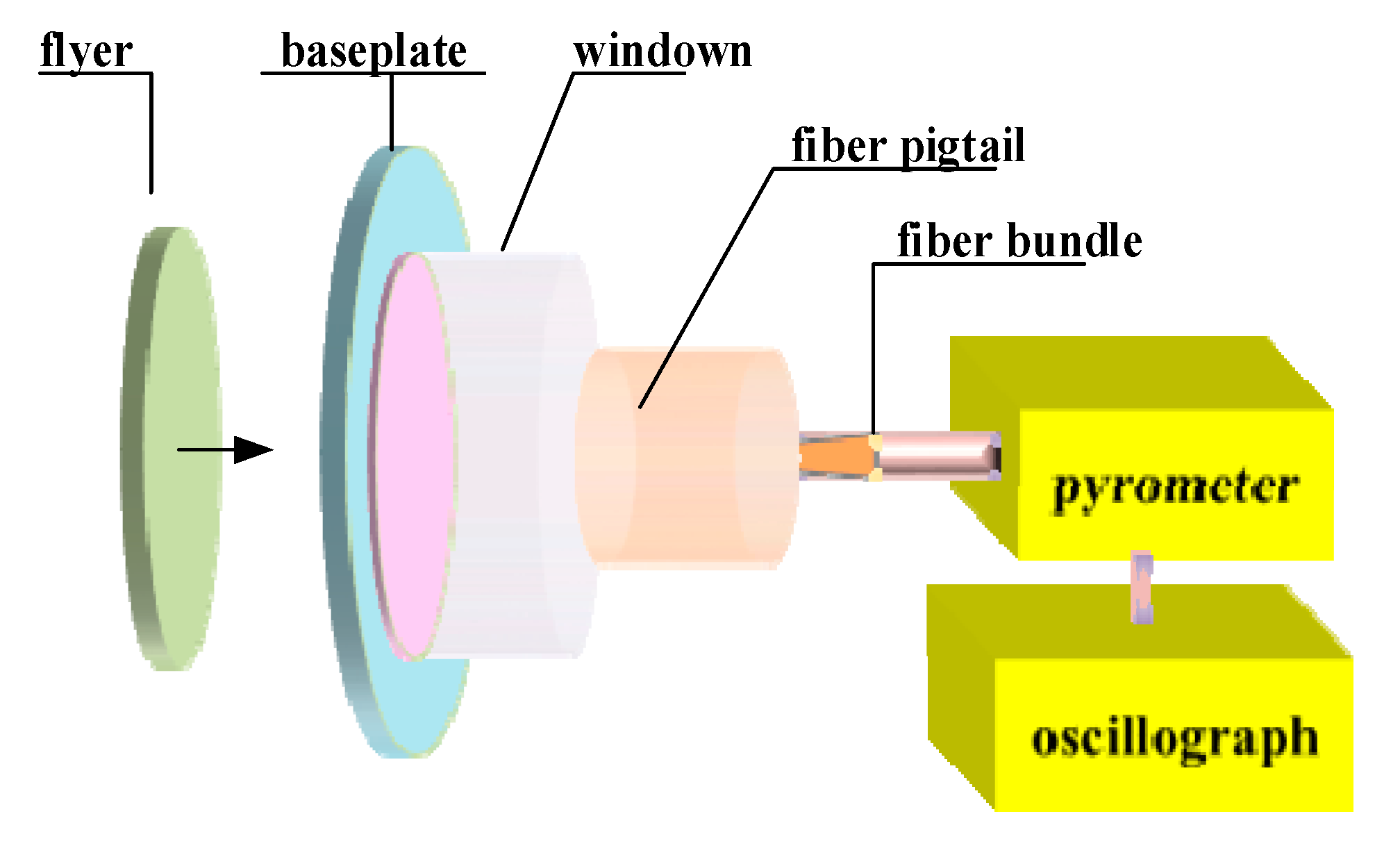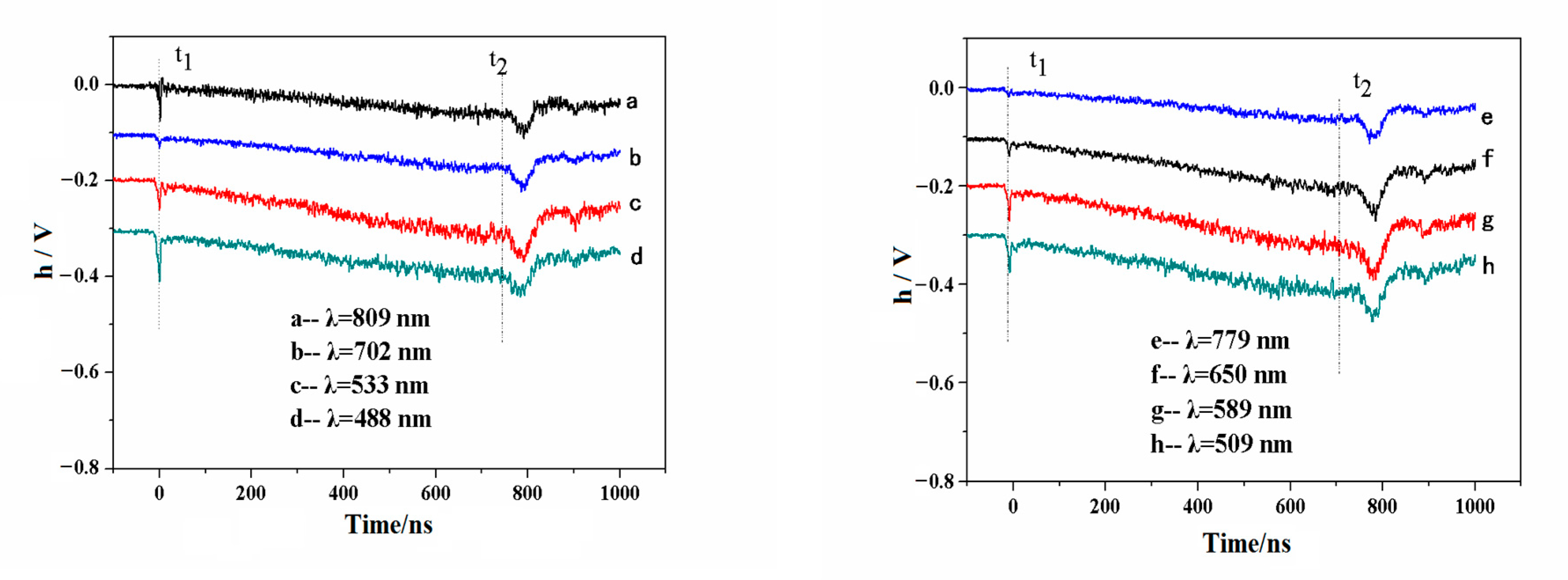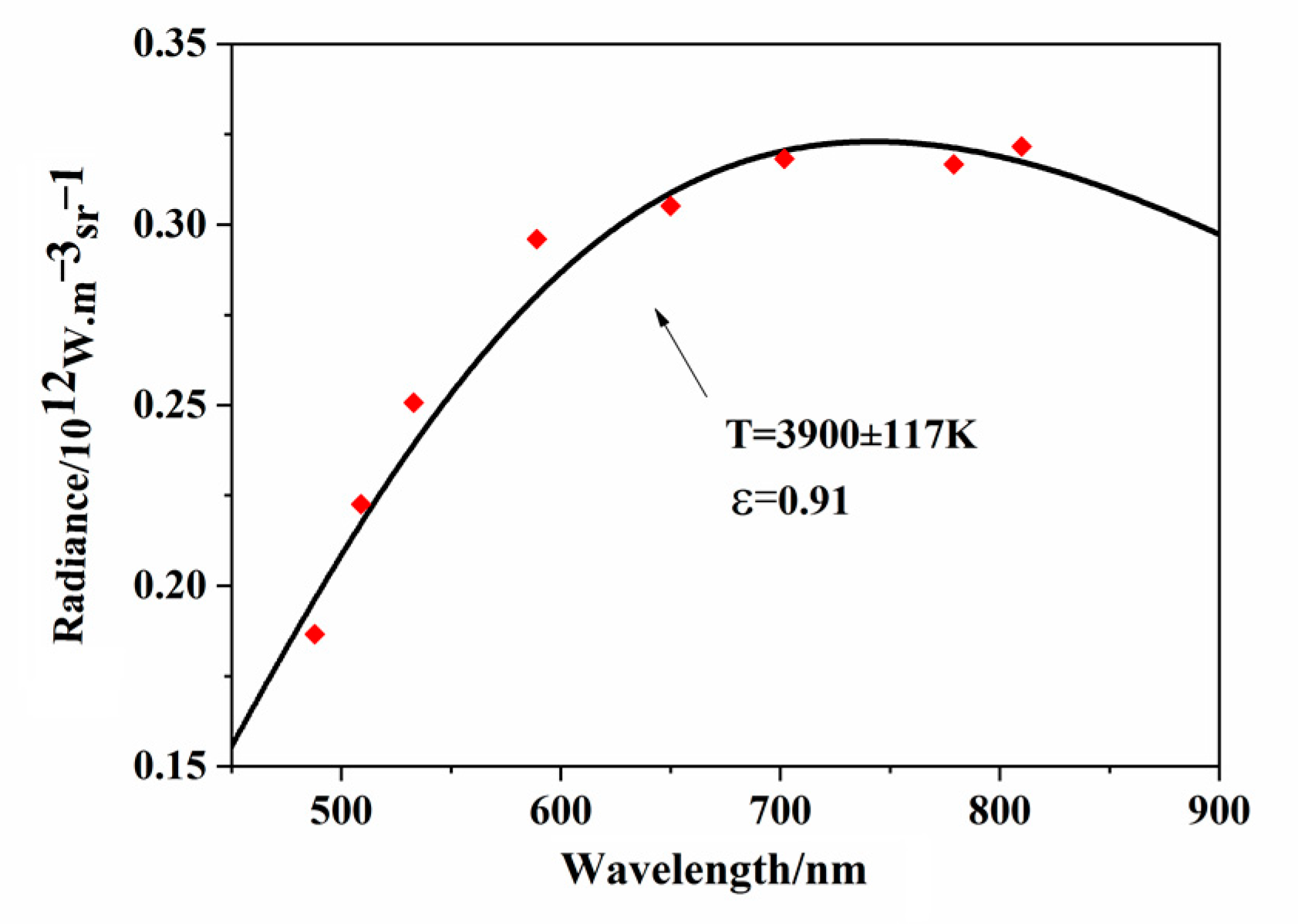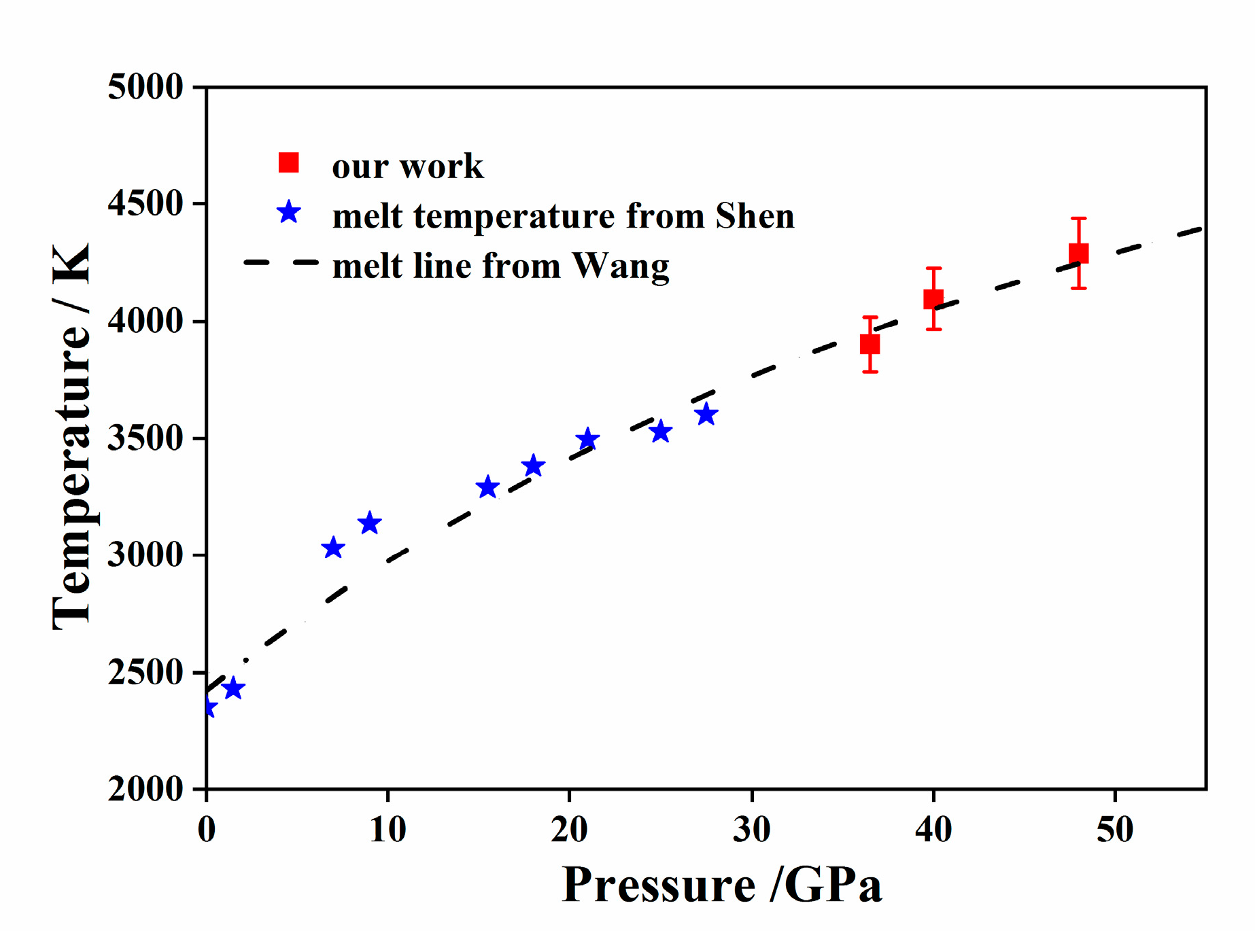The Radiation Temperature Characteristics of Sapphire under Shock Loading
Abstract
:1. Introduction
2. Experiment
2.1. The Experimental Principle
2.2. Design and Optimization of Optical Testing System
3. Experimental Results and Discussion
3.1. Spectral Signal Measurement of Sapphire
3.2. Analysis of Luminescent Signal
3.3. Inversion of Radiation Temperature
3.4. Radiation Temperature Analysis
4. Conclusions
Author Contributions
Funding
Institutional Review Board Statement
Informed Consent Statement
Data Availability Statement
Acknowledgments
Conflicts of Interest
References
- Capelle, G.A.; Mance, J.G.; Larson, E.D.; la Lone, B.M.; Stevens, G.D.; Turley, W.D.; Veeser, R.L. Simultaneous Raman and pyrometric temperature measurements in shock-wave-compressed toluene. J. Appl. Phys. 2019, 125, 225106. [Google Scholar] [CrossRef]
- Mao, H.; Chen, X.; Ding, Y.; Li, B.; Wang, L. Solids, Liquids, and Gases under High Pressure. Rev. Mod. Phys. 2018, 90, 015007. [Google Scholar] [CrossRef]
- Zel’dovich, Y.B.; Kormer, S.B.; Sinitsyn, M.V.; Kuryapin, A.I. Temperature and heat capacity of Plexiglas compressed by a shock wave. Dokl. Akad. Nauk. SSSR 1958, 122, 48–50. [Google Scholar]
- Kormer, S.B. Optical study of the characteristics of shock-compressed condensed dielectrics. Sov. Phys.—Uspekhi 1968, 11, 229–254. [Google Scholar] [CrossRef]
- Kondo, K.I.; Ahrens, T.J.; Sawaoka, A. Shock-induced Radiation Spectra of Fused Quartz. J. Appl. Phys. 1983, 54, 4382–4385. [Google Scholar] [CrossRef]
- Schmitt, D.R.; Ahrens, T.J. Temperatures of Shock-induced Shear Instabilities and Their Relationship to Fusion Curves. Geophys. Res. Lett. 2013, 10, 1077–1080. [Google Scholar] [CrossRef]
- Svendsen, B.; Ahrens, T.J. Shock-Induced Temperatures of MgO. Geophys. J. R. Astron. Soc. 1987, 91, 667–691. [Google Scholar] [CrossRef]
- Kondo, K.I. Window Problem and Complementary Method for Shock-temperature Measurements of Iron. AIP Conf. Proc. 1994, 309, 1555–1558. [Google Scholar]
- Hare, D.E.; Holmes, N.C.; Webb, D.J. Shock-wave-induced Optical Emission from Sapphire in th Stress Range 12 to 45 GPa: Images and Spectra. Phys. Rev. B 2002, 6, 81–88. [Google Scholar]
- Hare, D.E.; Webb, D.J.; Lee, S.H.; Holmes1, N.C. Optical Extinction of Sapphire Shock-Loaded to 250-260GPa. AIP Conf. Proc. 2002, 1231, 1231–1234. [Google Scholar]
- Brooks, W.P. Shock-induced luminescence in quartz. J. Appl. Phys. 1965, 36, 2788–2790. [Google Scholar] [CrossRef]
- Zel’dovich, Y.B. EMF produced by a shockwave moving in a dielectric. Sov. Phys. JETP 1968, 26, 159–162. [Google Scholar]
- Wang, Z.W.; Mao, H.H.; Saxena, S.K. The Melting of Corundum under High Pressure Conditions. J. Alloys Compd. 2000, 299, 287–291. [Google Scholar] [CrossRef]
- Liu, H.; Tse, J.S.; Nellis, W.J. The Electrical Conductivity of Al2O3 under Shock Compression. Sci. Rep. 2015, 5, 12823. [Google Scholar] [CrossRef] [PubMed]
- Liu, Q.C.; Zhou, X.M. Time-Resolved Light Emission of A, C and R-cut Sapphires Shock-compressed to 65 GPa. J. Appl. Phys. 2018, 123, 13–59. [Google Scholar] [CrossRef]
- Cao, X.; Wang, Y.; Li, X.; Xu, L.; Liu, L.; Yu, Y.; Qin, R.; Zhu, W.; Tang, S.; He, L.; et al. Refractive Index and Phase Transformation of Sapphire under Shock Pressures up to 210GPa. J. Appl. Phys. 2017, 121, 115903. [Google Scholar] [CrossRef]
- Cao, X.; Li, J.; Li, J.; Li, X.; Xu, L.; Wang, Y.; Zhu, W.; Meng, C.; Zhou, X. Refractive Index of R-cut Sapphire under Shock Pressure Range 5 to 65 GPa. J. Appl. Phys. 2014, 116, 093516. [Google Scholar] [CrossRef]
- Fat’yanov, O.V.; Webb, R.L.; Gupta, Y.M. Optical transmission through inelastically deformed shocked sapphire: Stress and crystal orientation effects. J. Appl. Phys. 2005, 97, 123529. [Google Scholar] [CrossRef]
- Hao, G.Y.; Liu, F.S.; Zhang, D.Y.; Zhang, M.J. Optical Emission of Directly Contacted Copper/Sapphire Interface under Shock Compression of Megabar. Appl. Phys. Lett. 2007, 90, 181–402. [Google Scholar] [CrossRef]
- Zhang, D.Y.; Liu, F.S.; Hao, G.Y.; Sun, Y.H. Shock Induced Emission from Sapphire in High-Pressure Phase of Rh2O3 (II) Structure. Chin. Phys. Lett. 2007, 24, 23–41. [Google Scholar]
- Zhang, N.; Liu, F.; Wang, W.; Sun, Y.; Liu, Q.; Peng, X.; Chen, J. Shock-Induced Optical Emission and High-pressure Phase Transformation of Sapphire. Phys. B Phys. Condens. Matter 2013, 429, 90–94. [Google Scholar] [CrossRef]
- Zhang, N.C.; Wang, P.; Hua, X.; Liu, F. Optical Radiation Characteristics and Structural Phase Transition of Sapphire under Megabar Pressure. Acta Opt. Sin. 2019, 39, 450–456. [Google Scholar]
- Ostrik, A.; Nikolaev, D. Shock induced melting of sapphire. J. Phys. Conf. Ser. 2022, 2154, 012010. [Google Scholar] [CrossRef]
- Fat’yanov, O.V.; Asimow, P.D. Contributed Review: Absolute spectral radiance calibration of fiber-optic shock-temperature pyrometers using a coiled-coil irradiance standard lamp. Rev. Sci. Instrum. 2015, 86, 101502. [Google Scholar] [CrossRef]
- Fat’yanov, O.V.; Asimow, P.D.; Ahrens, T.J. Thermodynamically complete equation of state of MgO from true radiative shock temperature measurements on samples preheated to 1850 K. Phys. Rev. B 2018, 97, 024106. [Google Scholar] [CrossRef]
- Bordzilovskii, S.A.; Karakhanov, S.M.; Khishchenko, K.V. Measurement of the brightness temperature of shock-compressed epoxy resin. Combust. Explos. Shock. Waves 2013, 49, 121–124. [Google Scholar] [CrossRef]
- Bordzilovskii, S.A.; Karakhanov, S.M.; Khishchenko, K.V. Brightness temperature of water compressed by a double shock to pressures of 60–79 GPa. Shock. Waves 2020, 30, 505–511. [Google Scholar] [CrossRef]
- Jing, F.Q. Introduction to Experimental Equation of State; Science Press Beijing: Beijing, China, 1999. [Google Scholar]
- Khishchenko, K.V.; Mayer, A.E. High- and low-entropy layers in solids behind shock and ramp compression waves. Int. J. Mech. Sci. 2021, 189, 105971. [Google Scholar] [CrossRef]
- Bruck, H.A.; Mcneill, S.R.; Sutton, M.A.; Peters, W.H., III. Digital Image Correlation Using Newton-Raphson Method of Partial Differential Correction. Exp. Mech. 1989, 29, 261–267. [Google Scholar] [CrossRef]
- Shen, G.; Lazor, P. Melting of Minerals under the Lower Mantle Conditions: Experimental result. J. Geophys. Res. 1995, 100, 17699–17713. [Google Scholar] [CrossRef]







| λ (nm) | 809 | 779 | 702 | 650 | 589 | 533 | 509 | 488 |
| Nr (μW/(cm−2.nm)) | 1.58 | 1.55 | 1.40 | 1.23 | 0.98 | 0.71 | 0.59 | 0.49 |
| Exp No. | Flyer Material | Base Plate Material | Flyer Size Diameter∙Thickness (mm) | Base Plate Size Diameter∙Thickness (mm) | c-Sapphire Diameter∙Thickness (mm) | Flyer Velocity (km/s) | Shock Pressure (GPa) | Radiation Temperature (K) |
|---|---|---|---|---|---|---|---|---|
| No. 1 | copper | copper | 23∙2.0 | 40∙2.0 | 24∙8.0 | 1.72 | 36.5 | 3900 ± 117 |
| No. 2 | copper | copper | 23∙1.8 | 40∙2.1 | 24∙8.0 | 1.96 | 40.2 | 4095 ± 131 |
| No. 3 | copper | copper | 23∙1.8 | 40∙1.8 | 24∙8.0 | 2.22 | 48.3 | 4290 ± 150 |
Publisher’s Note: MDPI stays neutral with regard to jurisdictional claims in published maps and institutional affiliations. |
© 2022 by the authors. Licensee MDPI, Basel, Switzerland. This article is an open access article distributed under the terms and conditions of the Creative Commons Attribution (CC BY) license (https://creativecommons.org/licenses/by/4.0/).
Share and Cite
Zhang, N.; Li, D.; Li, Y.; Gong, Z.; Wang, P.; Liu, F. The Radiation Temperature Characteristics of Sapphire under Shock Loading. Crystals 2022, 12, 1364. https://doi.org/10.3390/cryst12101364
Zhang N, Li D, Li Y, Gong Z, Wang P, Liu F. The Radiation Temperature Characteristics of Sapphire under Shock Loading. Crystals. 2022; 12(10):1364. https://doi.org/10.3390/cryst12101364
Chicago/Turabian StyleZhang, Ningchao, Duo Li, Yaqi Li, Zhaowei Gong, Peng Wang, and Fusheng Liu. 2022. "The Radiation Temperature Characteristics of Sapphire under Shock Loading" Crystals 12, no. 10: 1364. https://doi.org/10.3390/cryst12101364




